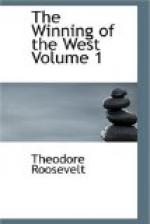The great confederacy of the Muscogees or Creeks, consisting of numerous tribes, speaking at least five distinct languages, lay in a well-watered land of small timber.[13] The rapid streams were bordered by narrow flats of rich soil, and were margined by canebrakes and reed beds. There were fine open pastures, varied by sandy pine barrens, by groves of palmetto and magnolia, and by great swamps and cypress ponds. The game had been largely killed out, the elk and buffalo having been exterminated and even the deer much thinned, and in consequence the hunting parties were obliged to travel far into the uninhabited region to the northward in order to kill their winter supply of meat. But panthers, wolves, and bears still lurked in the gloomy fastnesses of the swamps and canebrakes, whence they emerged at night to prey on the hogs and cattle. The bears had been exceedingly abundant at one time, so much so as to become one of the main props of the Creek larder, furnishing flesh, fat, and especially oil for cooking and other purposes; and so valued were they that the Indians hit upon the novel plan of preserving them, exactly as Europeans preserve deer and pheasants. Each town put aside a great tract of land which was known as “the beloved bear ground,"[14] where the persimmons, haws, chestnuts, muscadines, and fox grapes abounded, and let the bears dwell there unmolested, except at certain seasons, when they were killed in large numbers. However, cattle were found to be more profitable than bears, and the “beloved bear grounds” were by degrees changed into stock ranges.[15]
The Creeks had developed a very curious semi-civilization of their own. They lived in many towns, of which the larger, or old towns, bore rule over the smaller,[16] and alone sent representatives to the general councils. Many of these were as large as any in the back counties of the colonies;[17] but they were shifted from time to time, as the game was totally killed off and the land exhausted by the crops.[18] The soil then became covered by a growth of pines, and a so-called “old field” was formed. This method of cultivation was, after all, much like that of the southern whites, and the “old fields,” or abandoned plantations grown up with pines, were common in the colonies.
Many of the chiefs owned droves of horses and horned cattle, sometimes as many as five hundred head,[19] besides hogs and poultry; and some of them, in addition, had negro slaves. But the tillage of the land was accomplished by communal labor; and, indeed, the government, as well as the system of life, was in many respects a singular compound of communism and extreme individualism. The fields of rice, corn, tobacco, beans, and potatoes were sometimes rudely fenced in with split hickory poles, and were sometimes left unfenced, with huts or high scaffolds, where watchers kept guard. They were planted when the wild fruit was so ripe as to draw off the birds, and while ripening the swine were kept penned up and the horses were tethered with tough bark ropes. Pumpkins, melons, marsh-mallows, and sunflowers were often grown between the rows of corn. The planting was done on a given day, the whole town being summoned; no man was excepted or was allowed to go out hunting. The under-headman supervised the work.[20]




